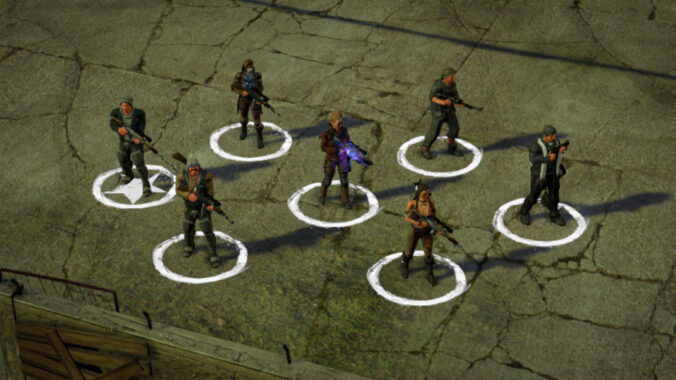Released in 2014 by inXile Entertainment, Wasteland 2 was a long-awaited revival of a cult classic. Funded through Kickstarter and helmed by Brian Fargo (the creator of the original Wasteland in 1988), it sought to deliver a true successor after decades of dormancy. While it succeeds in capturing the spirit of its predecessor and the roots of the franchise, it also shows both its indie origins and its design ambitions.
Within the Wasteland franchise, Wasteland 2 functions as both a sequel and a reinvention. Its narrative directly follows the original’s events: the Desert Rangers return, once again tasked with enforcing order in a chaotic, irradiated American Southwest. Unlike Fallout, which diverged into a new retro-futuristic aesthetic, Wasteland 2 stays grounded in its grittier, harsher world, more Mad Max than atomic-age satire. For longtime fans, this fidelity to tone and continuity was one of the game’s strongest selling points.
At its core, Wasteland 2 is a tactical, squad-based RPG with turn-based combat and heavy skill reliance. Players control a team of up to seven characters, balancing a wide range of abilities: lockpicking, demolitions, survival, animal whispering, and more. The depth here is both rewarding and punishing. Poor skill allocation can lock you out of entire story paths.
I created my team with a Leader (armed with assault rifles and focused on leadership, barter, and the three persuasion skills available), a Rogue (armed with assault rifles and focused on alarm disarming, demolitions, lockpicking, and safecracking), a Techie Medic (armed with energy weapons and focused on computer science, mechanical repair, field medic, and surgeon), and a Sniper (armed with sniper rifles and focused on outdoorsman, perception, and weaponsmithing). For the three extra companions you can pick along the way, I went with Vulture’s Cry (made her a second sniper and animal whispering expert), Scotchmo (who can resist a hobo with a shotgun?), and Neil Thomas (a second field medic and surgeon, armed with submachine guns).
The interface can feel dated and cumbersome at the beginning, but I got used to it. Inventory management is clunky, looting takes too many clicks, and sorting through your team’s gear becomes tedious. While later patches improved quality-of-life features, the overall user experience never fully reached the polish of contemporary RPGs.
One of Wasteland 2‘s defining traits is its bleak, irreverent humor. Corpses deliver punchlines. Death cults mock religion while embracing nukes as divine relics. Conversations spiral from solemnity into absurdity without warning. Among the best examples is the wandering tortoise, a seemingly insignificant animal that, if followed patiently across a desert, leads you to a buried treasure. It’s a perfectly Wasteland moment: equal parts frustrating, hilarious, and rewarding, capturing the unpredictability that defines the franchise’s tone.
A standout feature is the nuclear device displayed in the Ranger Citadel museum. Players who trigger it will instantly end their campaign. But the game offers a clever twist: you can start over in Ranger Veteran Mode, importing your old characters with their hard-earned stats (not their equipment, though). It’s a rare, gutsy design choice that turns failure into a strange kind of reward, blending narrative and meta-game progression in a way few RPGs attempt. I used that nuke and restarted my game with characters at level 10, which didn’t make them overpowered but gave me a little edge to avoid some frustration in the early game.
One area where Wasteland 2 falters is in loot design. Far too often, rewards feel underwhelming compared to the effort required. After clearing challenging encounters or navigating dangerous radiation zones, players are greeted with meager gear that’s quickly outclassed by shop inventory. In a game where scavenging is thematically central, this undermines the sense of post-apocalyptic scarcity the narrative tries to convey.
Despite multiple patches and a remastered Director’s Cut, a handful of persistent bugs remain. Radiation suits sometimes fail to register, forcing tedious workarounds. Certain quest triggers can break if objectives are completed out of order. While rarely game-breaking, these issues interrupt immersion and can be especially frustrating in a game that encourages nonlinear exploration.
Wasteland 2 builds to a climactic confrontation between rival factions competing to reshape the post-apocalyptic world. The player’s choices carry significant weight, influencing alliances, Ranger reputations, and the survival of entire settlements. While the branching paths give the finale replay value, some players may find the resolution abrupt: character arcs end suddenly, and not all plot threads feel entirely tied off.
However, the game earns credit for rejecting neat, happy endings. True to the franchise’s spirit, the wasteland remains dangerous and unstable no matter what you do. Victory comes at a cost, reinforcing the series’ recurring theme: survival isn’t triumph, it’s just endurance.
